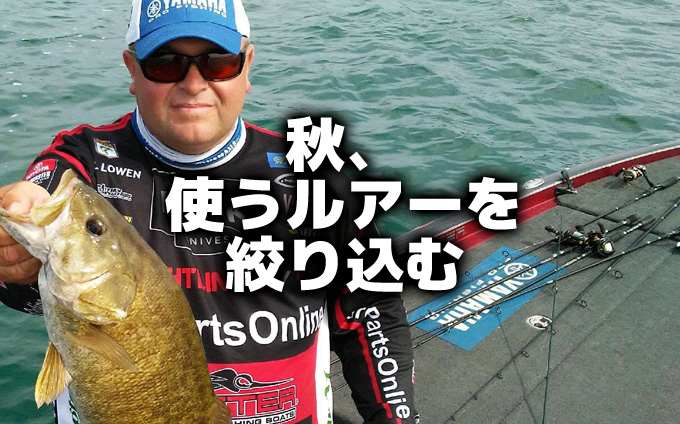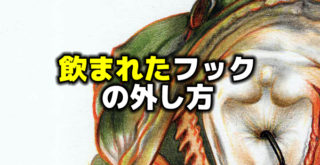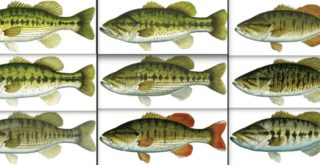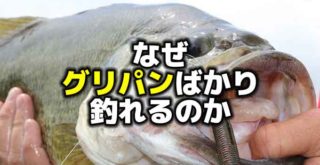秋のバス釣り:5つのベストポイント

Photo by game and fishmag.com
こんにちは!店長の小山です!
本日は海外サイトより、”5 Hotspots For Fall Bass”という記事を引用してご紹介いたします。
引用先:gameandfishmag.com”5 Hotspots For Fall Bass”by John Neporadny Jr. October 23rd, 2017(海外サイトです)
秋のバス釣りについて。
このブログでも再三にわたって海外のプロや記者さん方の記事を紹介させていただいていますが、いくら読んでも、秋のバス釣りは本当に難しいと思います。
サイズにこだわらなければ、ある程度の数は釣れることもあります。しかしサイズにこだわると小バスのバイトは消えてしまい、バイトが恋しくなるとまた小バス釣りにシフトしてしまい、強い心を持ってビッグバスを追いかけるのが難しい、そんな悪循環に私はよく陥ってしまいます。
ベイトフィッシュを追うことが秋のバス釣りには有効な戦術になるというのはわかるのですが、他になにか手がかりとなるようなことはないのでしょうか。
また、秋といっても11月の晩秋を迎えるころになると、バスたちはディープに落ちていきますので、さらに難しくなると思うのですが、このあたりも知りたいところです。
この記事は、アメリカの総合アウトドアメディア「GAME&FISH」の記事で、バスマスターやFLWを20年以上も取材を続けるアウトドア作家(記者)のジョン・ネポラドニー・ジュニア氏が、11月にバスを釣るための5つのスポットとその釣り方を各バスプロに取材し、紹介してくれています。
11月にバスがフィーディングするところはどんなところなのか、ぜひ読んでみましょう。
ウィード
Bass tournament pro Jacob Wheeler believes November can be the toughest time of the year to catch bass, so he tries to cover a lot of water. “In the fall transition, a lot of bass are scattered out and weeds seem like the best deal going,” Wheeler said. He increases his catch rate by keying on bass relating to the grass flats on the main lake or in bays and creeks.
Wheeler tries to locate sweet spots in the vast stretches of weedy flats. “I am always looking for a transition in those flats with grass in it, whether it is a ditch or a point — something that is a little bit different,” he said. “Bass are normally going to be on something that is irregular.”
As the water gets colder, the shallow grass starts dying out and bass move to the deeper grassbeds where they suspend in the tops of the submerged aquatic vegetation to ambush baitfish. Wheeler tempts these aggressive fish by throwing topwater lures over submerged weeds.
His favorite topwater lures for bass in the weeds are a Rapala Skitter V and Storm Arashi Top Walker. Weather conditions dictate which type of topwater Wheeler works over the weedtops. On calm days, he prefers the subtle walking action of the Top Walker, but he switches to the Skitter V when wind creates choppy water. The Skitter V spits and sputters and produces a loud knocking sound that helps bass hone in on the bait easier on the turbulent surface.
バストーナメントプロのジェイコブ・ウィーラーは、11月はバスをキャッチするのに最も厳しい時期になると考えているので、広いエリアをカバーしようとしています。 「秋が進むと、多くのバスが散ってしまいますので、ウィードが最善の場所のように思います。」とウィーラー氏は言います。彼は、メインレイクのウィードフラットやワンド内のクリークをキーとして、キャッチ率を上げてます。
ウィーラーは、広大なウィードフラットからスイートスポットを見つけ出そうとします。 「私は、ウィードポケットやウィードの岬などウィードフラットにある変化を常に探しています。なにか少しでも違うものです。バスは通常、不規則なものにつくものです。」
水温が下がるにつれて、シャローのウィードが枯れていき、バスはより深いウィードエリアに移動し、水中のウィードのトップにサスペンドしてベイトフィッシュを待ち伏せします。ウィーラーはこうした水中のウィードのある場所でトップウォーターを投げることによって、これらアグレッシブな魚を誘います。
ウィードエリアでの彼のお気に入りのトップウォータールアーはラパラ・スキッターVとストーム・アラシ・トップウォーカーです。天候により、どのタイプのトップウォーターがウィードに対して有効かをウィーラーは決めます。穏やかな日には、彼はトップウォーカーの繊細なウォーキングアクションを好みますが、風が水面を荒らす時はスキッターVに切り替えます。 スキッターVはスプラッシュを出し、音を立てて、激しいノッキング音も発生させ、荒れた水面でバスがルアーを見つけるのを容易にします。
レイダウン
A fallen tree jutting from the bank is another fast-food spot for bass because it provides ambush points from shallow water at one end of the log to deep water at the other end.
A well-known champion of numerous bass tournaments, David Fritts keys on laydowns in dirty water with a visibility of only 1 to 1 1/2 feet. “If I had only one thing to fish, then it would definitely be wood,” Fritts said of his main target for November bass.
Banging a square-billed crankbait into the logs is Fritts’ favorite method for catching bass from the wood cover. “The main deal with a square bill is it reacts differently when it hits cover,” he said. Fritts notices after it hits the log a square-billed crankbait will deflect wider than a round-lipped crankbait, and that triggers more reaction strikes.
Fritts initially throws his crankbait to the edges of the laydown to catch bass roaming outside the cover. Then he casts to the middle of the log to tempt bass holding tight to the wood.
“To be effective in a laydown you have to get your bait through it,” Fritts said. “If you hang every time you throw it in there you are not going to catch many fish.”
Fritts prevents hanging up his lure by winding it at a medium to medium-fast pace on a 5.1:1 gear-ratio baitcasting reel. When the crankbait hits a limb, he raises his rod slightly allowing the lure to float up and then quickly cranks the reel so the lure bangs into the cover again.
バンクから突き出たレイダウンは、片方のシャロー側から反対側の深いほうまで待ち伏せポイントを提供するので、バスのフィーディングスポットとなります。
数多くのバス・トーナメントで有名なチャンピオンのデビッド・フリッツは、視界がわずか30~45センチしかないような濁った水の時にレイダウンをキーにします。 「私が1ヶ所でしか魚を釣ることができないのだとしたら、それは確実に木でしょう。」とフリッツは11月のバスのメインターゲットについて言います。
レイダウンにスクエアビルクランクを当てていくことは、ウッドカバーのバスをキャッチするためのフリッツの好きな方法です。 「スクエアビルを使う主な理由は、カバーに当たったときに異なる反応をすることです。」と彼は言います。フリットはレイダウンに当たった後、スクエアビルクランクベイトがラウンドリップのクランクベイトよりも大きくそれるため、リアクションバイトが多く発生するということです。
フリットは最初、クランクベイトをレイダウンの端に投げ、カバーの外側の回遊バスをキャッチします。それから彼は、木の中にぴったりと付いたバスを誘うためにレイダウンの中央に投げつけます。
「レイダウンで効果的に釣るためには、ルアーをしっかり通してくる必要があります。」とフリッツ氏は言います。 「そこに投げ込むたびに引っ掛かってしまうようでは、多くの魚をキャッチすることはできないでしょう。」
フリットは、5.1:1のギア比のベイトキャスティングリールで、ミディアムからミディアムファーストで巻くことで根掛かりを回避しています。クランクベイトが枝に当たったとき、彼はロッドを少し持ち上げてルアーが浮き上がらしてから、リールを素早く巻いてルアーが再びカバーに当てていくようにします。
ボートドック・桟橋
“Docks are good all year long because they offer shade, and people put brushpiles around a lot of docks,” said bass-fishing pro Terry Scroggins. “A lot of guys also have feeders on the docks. There are so many things that draw fish to docks that they stay good most of the year, but that time of the year (November) is really good.”
Bass suspend under floating docks where they can ambush baitfish feeding on the algae that grows on the dock flotation. Scroggins keys on docks leading out of the backs of pockets and creeks during November.
Most of the time Scroggins prefers swimming a white 3/8- or 1/2-ounce jig to catch bass suspending under the dock. He matches the jig with a Zoom Super Chunk and skips it under the dock where he retrieves the bait with a pumping action to keep it swimming within about 1 1/2 feet of the surface. When he wants to create more commotion while swimming the jig, Scroggins adds a Zoom Super Speed Craw or a Strike King Rage Craw to the jig and cranks the combo at a steady pace.
「船は日陰を提供してくれるので一年中有効です。そして、人々は桟橋にブラッシュパイル(オダ)を置いています。」とバスプロのテリー・スクロギンス氏は語った。 「誰もが、桟橋はいいといいます。桟橋に魚が寄るというのは年中そうなのですが、11月は本当に良いです。」
浮桟橋に生えた藻を食べるベイトフィッシュを待ち伏せするため、バスは浮桟橋の下でサスペンドします。 スクロギンスは11月に小さなワンドやクリークの奥にある桟橋をキーとしています。
ほとんどの場合、スクロギンスは白い3/8または1/2オンスのジグをスイミングさせ、ドックの下にサスペンドするバスをキャッチすることを好みます。ジグとズーム・スーパーチャンクを組み合わせ、ドックの下へスキッピングで入れ、トゥイッチしながらリトリーブし、水面から約15センチ以内を泳ぐようにします。ジグを泳がせるのにもう少し波動が欲しいときは、ズーム・スーパースピードクローまたはストライクキング・レイジクローをジグにつけ、それを安定したペースで巻いていきます。
岩
Baitfish and bass are both attracted to the warmth of the rocks that absorb and retain the sun’s heat even on cold November days.
Marcus Sykora, another tournament champion, looks for wind-blown rocky banks in November. That’s because he knows bass will be feeding on baitfish there. “I actually like to fish hard transitions where the bank goes from big rock to little rocks, or some sort of continuous blend of some ledge rock, gravel and some good-sized rock in it,” he said.
Waking a 1/2-ounce spinnerbait with tandem willow-leaf blades is Sykora’s most productive tactic for catching bass on the rocks. “Waking a spinnerbait mimics a lot of the things bass are feeding on in the rocks and it causes not only a hunger strike but also a reaction strike,” Sykora said. He also likes to wake spinnerbaits a lot because, “it is a great way to cover water.”
The tournament competitor positions his boat over 12 to 20 feet of water and points the boat’s nose at a 30- to 45-degree angle to the bank. By presenting his lure at that angle, Sykora can keep the spinnerbait in the strike zone longer. He retrieves the spinnerbait fast enough that its blades bulge the water but don’t break the surface.
ベイトフィッシュとバスの両方とも、寒い11月の日には太陽の熱を吸収して保持する岩の暖かさに魅了されます。
別のトーナメントチャンピオンのマーカス・シコラは、11月には風の当たる岩場を探します。そこでバスがベイトフィッシュをフィーディングすることを知っているからです。 バンクに大きな岩から小さな岩まで、あるいは何らかの岩石、砂利とそこにある程度の大きさの岩が連続的に混ざり合っているような、ハードボトムの変化を釣りたいと思っています。
1/2オンスのタンデムウィローのスピナーベイトをウェイキングすることは、岩場のバスをキャッチするためのシコラの最も有効とする戦術です。 「スピナーベいトのウェイキングは、バスが岩場で食べているものの多くを模倣し、食性によるバイトだけでなくリアクションバイトも引き起こします。また、それは広いエリアをカバーする素晴らしい方法です。」という理由で、スピナーベイトのウェイキングを多用するのが好きだそうです。
トーナメントの選手は、自分のボートを水深3.6〜6メートルの水上に配置し、ボートをバンクに対して30〜45度の角度で向けます。その角度でルアーをプレゼンテーションすることによって、シコラはストライクゾーンにスピナーベイトを長く保つことができます。彼はブレードが水面を膨らませつつ水面から飛び出さないようにスピナーベイトをすばやくリトリーブします。
立木
Reservoirs with flooded timber provide a jungle of cover for migrating bass in November. Two types of wood cover bass seek during this time of year are pole timber (the broken-down remains of hardwood trees) and petrified cedar trees.
Veteran fishing guide and bass fishing competitor Pete Wenners keys on standing timber in November. That’s because he knows the trees provide cover for bass waiting to pick off migrating baitfish. He keys on timber situated along a baitfish migration route, places such as creek channels or secondary points.
Wenners suggests an ideal hotspot for November is an isolated cedar tree mixed in with pole timber. “The cedar trees are so good because they are usually where the dropoffs are,” Wenners said. “The cedars normally will be in the shallow water (less than 20 feet deep) but are real close to a steeper bank or drop.”
The cedars also provide thicker cover than pole timber and absorb heat better so bass snuggle against the trees and suspend at various depths, depending on the water temperature and the depth of the baitfish.
A spinnerbait is the best lure option for throwing to bass in standing timber because the blade baits can be fished at various depths. The blade bait can be waked on the surface for bass suspended in the treetops or slow-rolled down to depths of 15 to 20 feet. When targeting bass in the treetops, Wenners opts for a 3/8- or 1/2-ounce spinnerbait with tandem willow-leaf blades in No. 3 and No. 3 1/2 sizes. He switches to a 3/4- or 1-ounce spinnerbait with No. 5 and 6 blades for slow-rolling to bass suspended deeper in the trees.
リザーバーに沈む立木は、11月の回遊するバスにジャングルを提供します。この時期にバスが探すウッドカバーは、ポール材(倒れかかった固い木材)や石化した杉の木の2種類があります。
ベテランフィッシングガイドでありバスフィッシングトーナメンターのピート・ウェンナーズは11月には立ち木をキーとしています。それは、回遊性のベイトフィッシュを待ち伏せするのにバスは立木に隠れることを知っているからです。彼は、クリークチャンネルやワンド内の岬などのベイトフィッシュの移動ルートに沿って位置する立ち木をキーとしています。
ウェンナーズは、11月の理想的なホットスポットは、多くの木が集まるなかでも孤立した杉の立木であると言います。 「スギの木は、通常、ブレイクラインに位置するのでとても良いです。」とウェンナーは言います。 「杉は通常、浅い水深(深さ6m以内)の場所にありますが、本当に急なバンクやドロップオフの近くにあります。」
杉はまた、ポール材よりも厚いカバーを提供し、熱をより良く吸収して、バスが木にぴったりと付き、水温やベイトフィッシュのレンジに応じてさまざまな深さでサスペンドしています。
スピナーベイトは、様々なレンジを通すことができるので、立木のバスに投げるための最良のルアーです。ブレードベイトは、水面をウェイキングすることもできますし、立木の水深4.5~6メートルにサスペンドしバスへスローロールで通すこともできます。 ウェンナーズは、立ち木のトップにいるバスをターゲットにしたときには、#3と#3.5のブレードのダブルウィローの3/8か1/2オンスのスピナーベイトを選択します。立木の深いところでサスペンドするバスには、#5と#6のブレードを持った3/4から1オンスのスピナーベイトに切り替え、スローロールで探っていきます。
いかがでしょう、11月のバスフィッシングとはこんな感じだそうです。
皆さんは心当たりがありましたでしょうか。
ひとつひとつのポイントを見ていくと、「そんなの全部1年中いいポイントでしょう」と思ってしまうのですが、11月ということに焦点を当てると、他の月とは微妙に考え方や攻め方が違っているようですね。
同じストラクチャーやカバーでも、季節や月によって攻め方を変えて釣ることができる。これは非常にエキスパートな感じがしてかっこいいですね。
私はいつも同じストラクチャーを季節問わず同じように攻めてしまう傾向がありますので、こういう風に理由を明確に持って、ルアーを替えたり通し方を変えて攻めてみたいものだと思いました。
秋はベイトフィッシュと言いますが、この記事を読んでお分かりの通り、「ベイトフィッシュ+何か」ということを意識して釣りをしていこうと思います。
それでは、また。
毎度ありがとうございます!




























